This tutorial on how to make Swiss Meringue buttercream is the only resource you’ll need to make the smoothest, silkiest frosting!
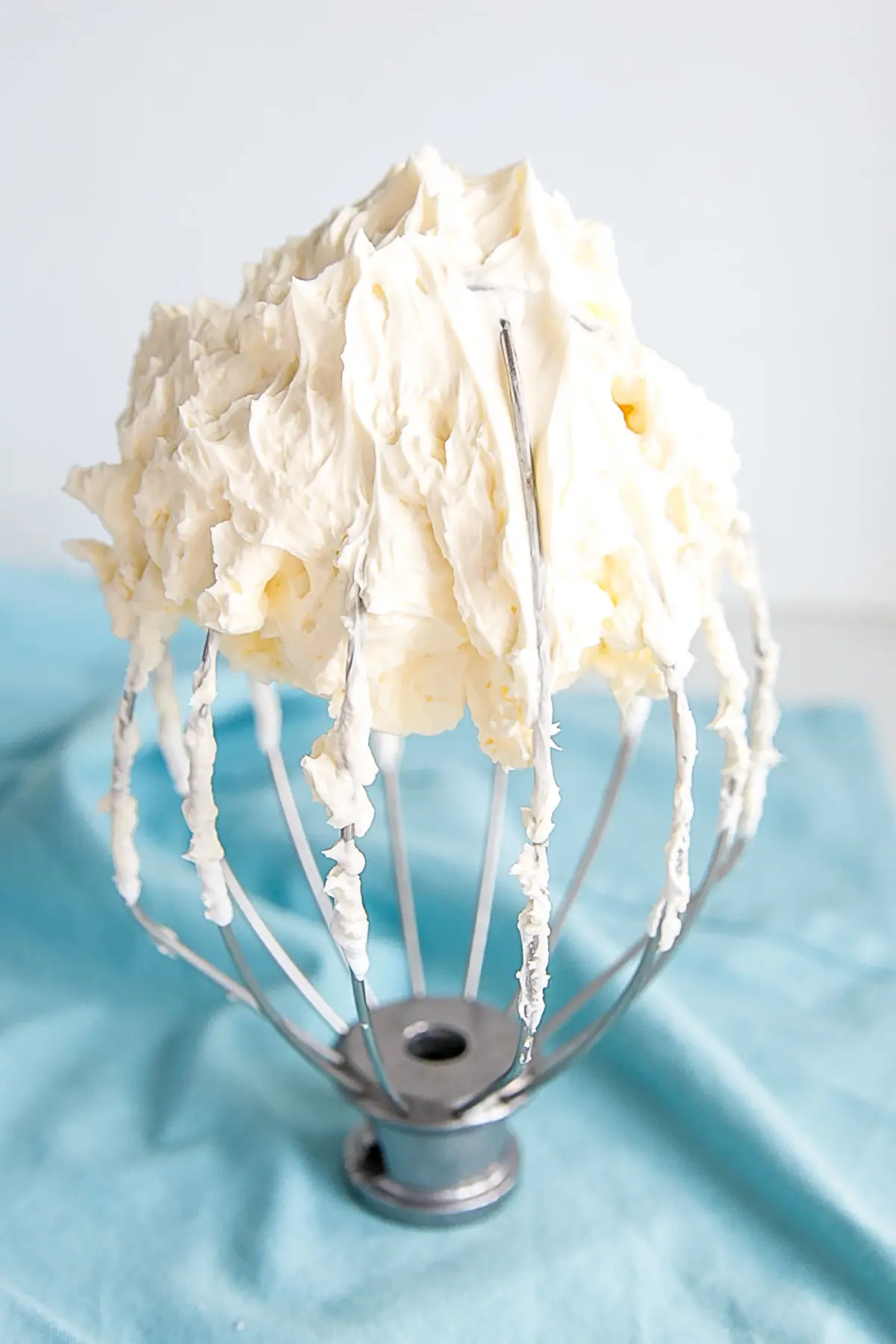
The topic of Swiss meringue buttercream comes up regularly in my Baking group on Facebook and in comments on some of my recipes here — how to make it, but more often how to deal with it when it’s just not cooperating.
Meringue buttercreams can be a bit temperamental, but whatever state you’ve got it in (provided you started with a stiff peak meringue) is totally saveable.
If you love Swiss meringue buttercream as much as I do, hopefully, you’ll find these tips useful.
If you’ve never tried it and are intimidated by it, I hope this tutorial will give you the confidence to give it a shot.
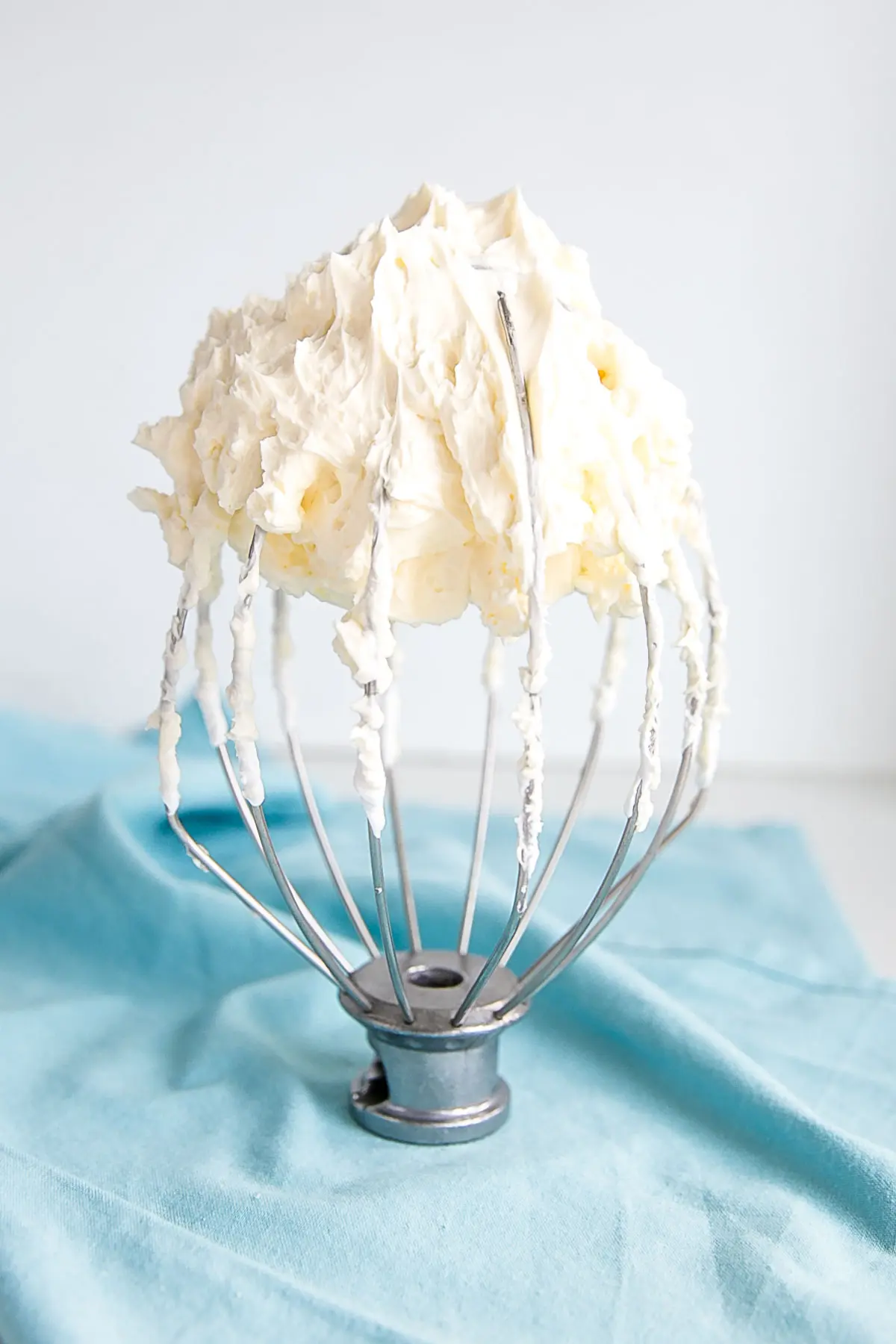
What is Swiss Meringue Buttercream?
Though more involved than an American buttercream, Swiss meringue buttercream (SMBC) is the easiest of the meringue buttercreams. It involves cooking eggs and sugar over a double boiler, whipping them into a meringue, then adding butter and flavorings.
The other two meringue buttercreams (Italian and French) both involve pouring boiling sugar into a partially whipped egg and sugar mixture.
They are equally delicious and known to be a bit more stable, but I find boiling sugar to be stressful and intimidating, so generally stay away from it as much as possible.
If you’re feeling adventurous though and you’ve tried SMBC before, I encourage you to give those a go and see how you like them.
Swiss meringue buttercream consists of 3 very simple ingredients:
- Egg whites
- Sugar
- Unsalted butter
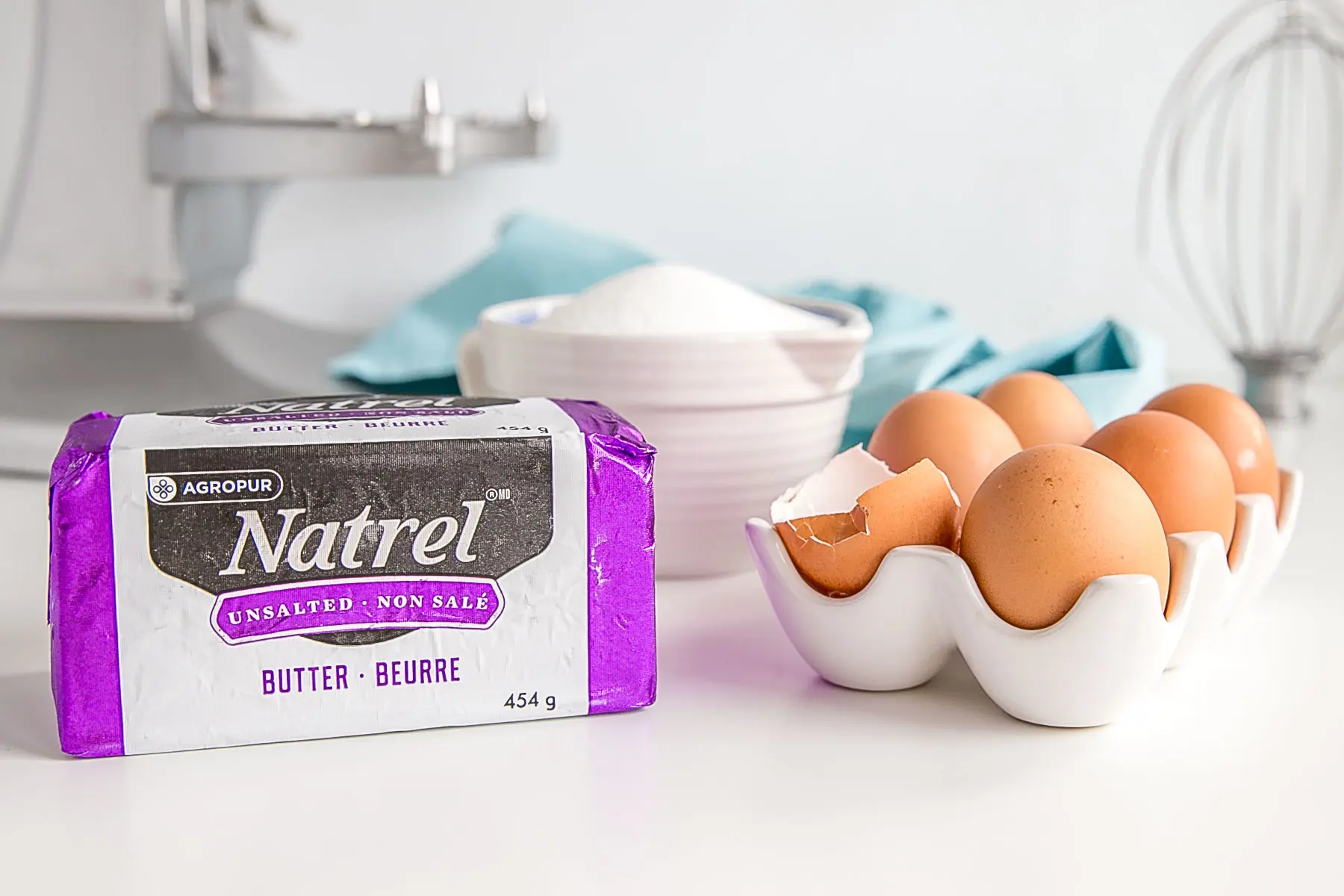
From there, you can flavor to your heart’s content. A simple and standard recipe will include vanilla, but the flavor possibilities are limited only by your imagination.
You can add melted chocolate for a milk, white, or dark chocolate Swiss meringue buttercream, freeze-dried berries for fruit flavor and color, peanut butter/peanut butter powder (preferred), or choose from a variety of flavorings to add in.
How to Make Swiss Meringue Buttercream
I’m going to take you through each step of the process here and call out tips or issues you may run into.
I recommend using a stand mixer for this buttercream. You likely could do it with a hand mixer, but it would be a more painful process — you’d be holding that hand mixer for a good 20+mins. As such, the steps I describe are for a stand mixer, but you can adapt to a hand mixer if that’s all you have to work with.
The very first thing you must do, this is NOT optional, is:
Step #1 – Wipe down all tools with lemon juice or vinegar
To help ensure a stable and stiff meringue, you must make sure that everything that will come in contact with the egg whites is completely grease-free. This includes things like your:
- mixer bowl
- whisk attachment
- hand whisk
- measuring cup (that will be used to scoop sugar)
- small bowl(s) (to crack eggs into when separating whites)
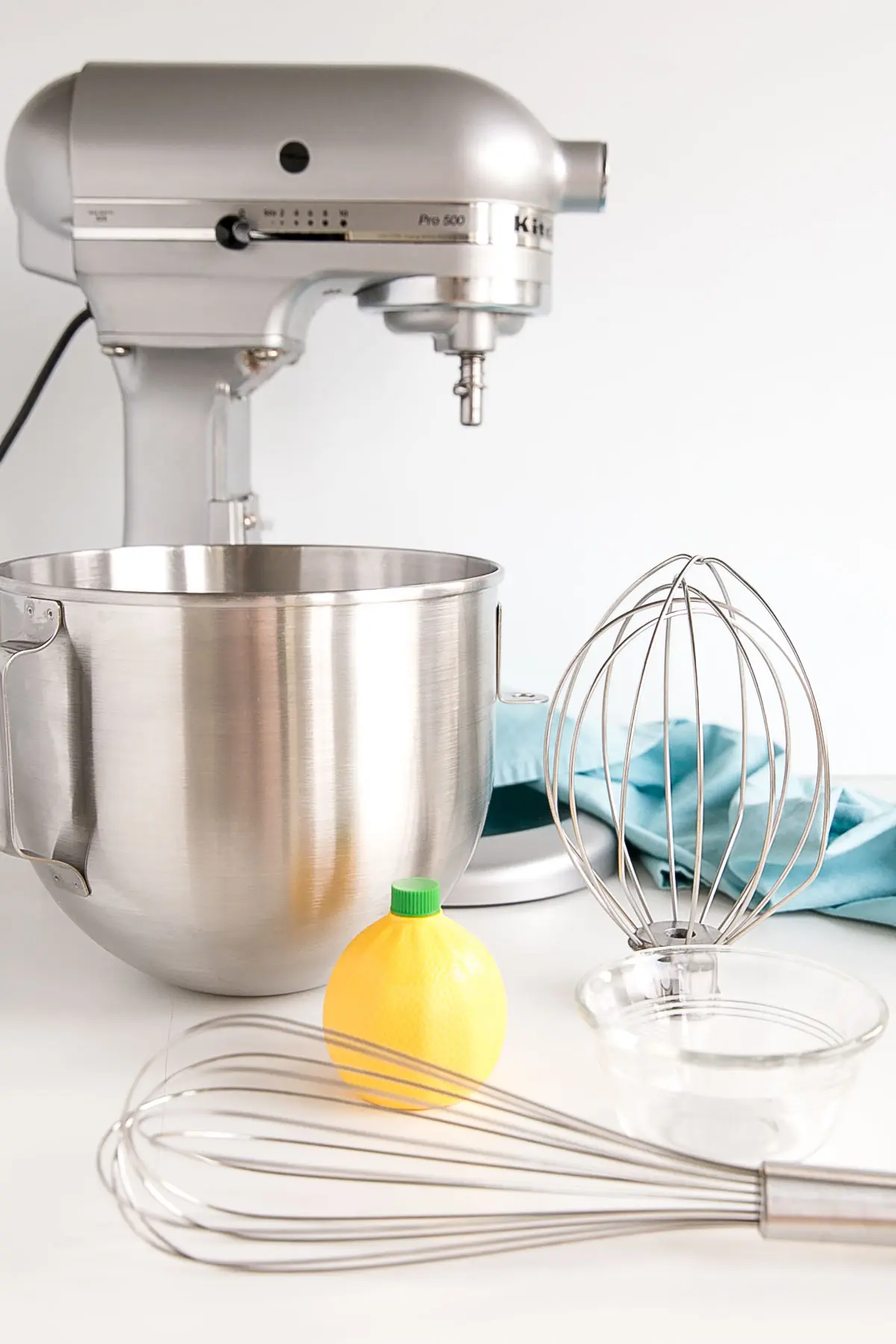
Grease is meringue’s enemy.
Even the tiniest speck of grease (or egg yolk) will cause the meringue to not whip to a stiff peak and result in a less-than-perfect (aka dense and greasy) Swiss meringue buttercream.
Another important tip here is to not use plastic tools, especially bowls, when making Swiss meringue. Plastic has a tendency to retain grease no matter how thoroughly it’s cleaned.
Best to be safe and stick to metal (preferred) or glass bowls.
Step #2 – Bring a medium pot of water to a simmer (1-2 inches of water)
You’ll want a pot that’s big enough to comfortably place your mixer bowl onto, but not so big that the bottom of the bowl touches the water.
You want a maximum of 1-2 inches of water in the pot. Bring this to a boil, then reduce to a low simmer.
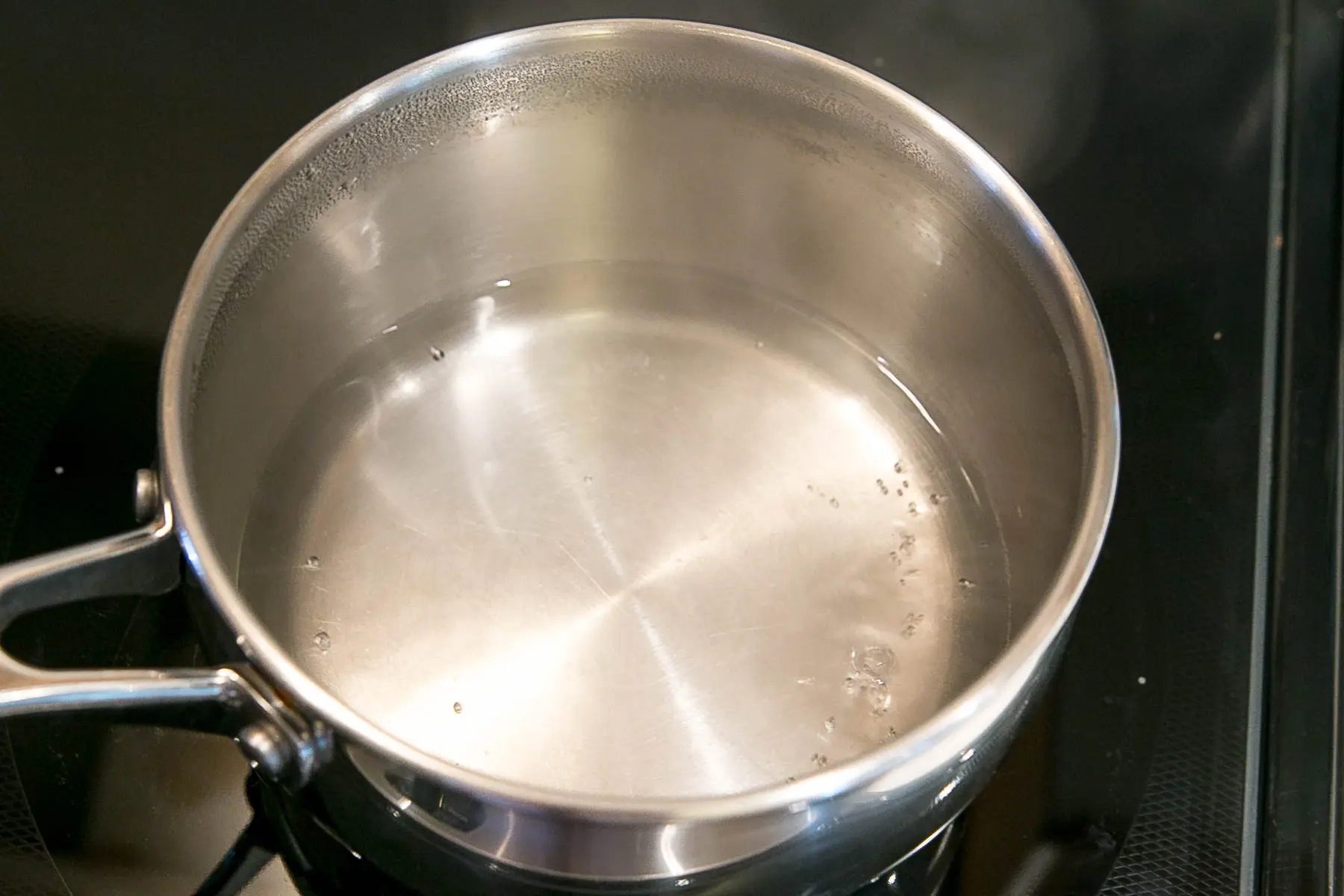
Step #3 – Separate your egg whites
Separate each egg white into a small bowl, then transfer into your mixer bowl.
Do not separate the egg whites directly into your mixer bowl. If you do that and have even one cracked yolk, you will ruin the whole batch of whites.
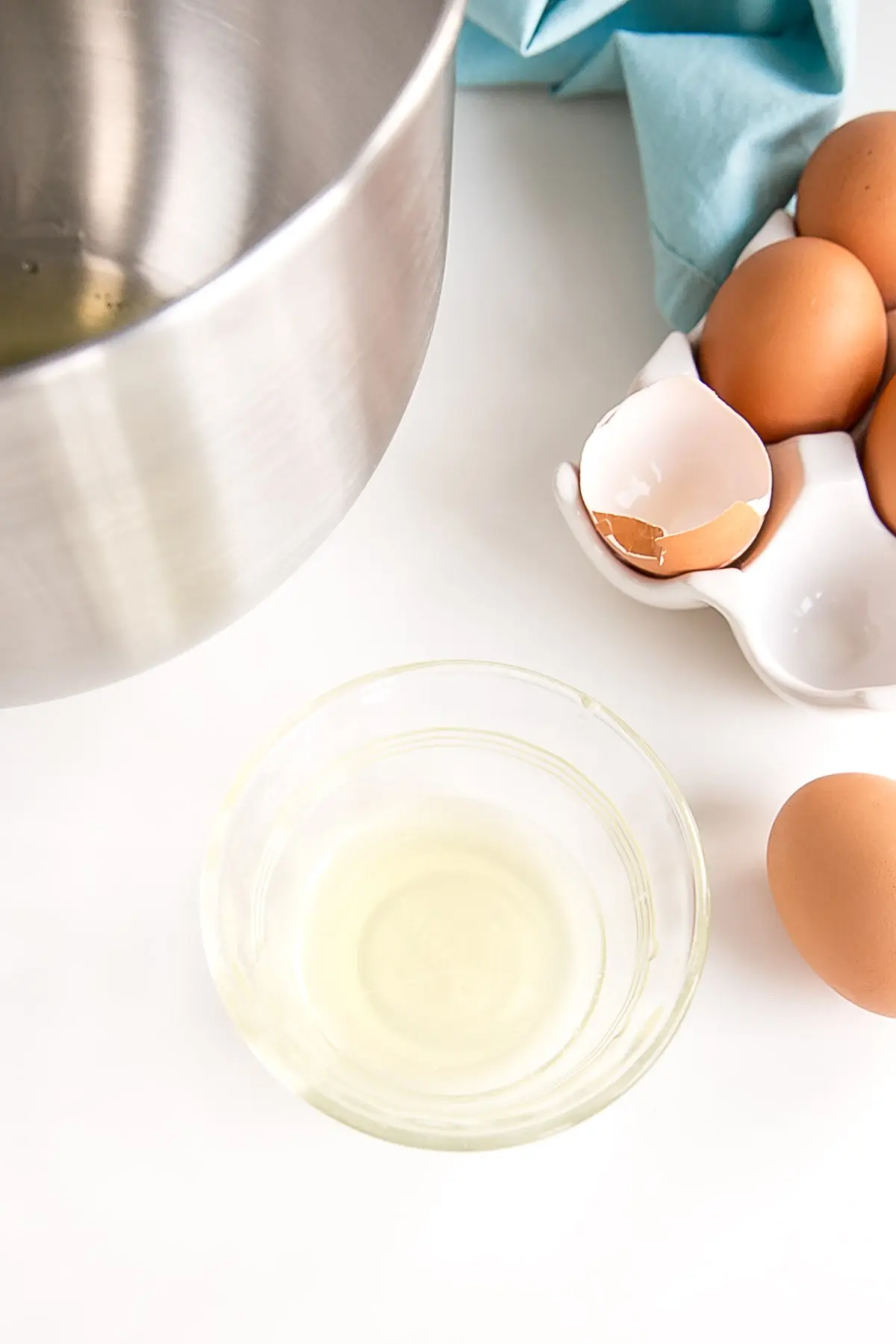
It’s best to separate each egg individually.
Even a speck of yolk will cause the meringue to not whip up properly. Do not attempt to make a meringue if your egg whites are not completely yolk-free.
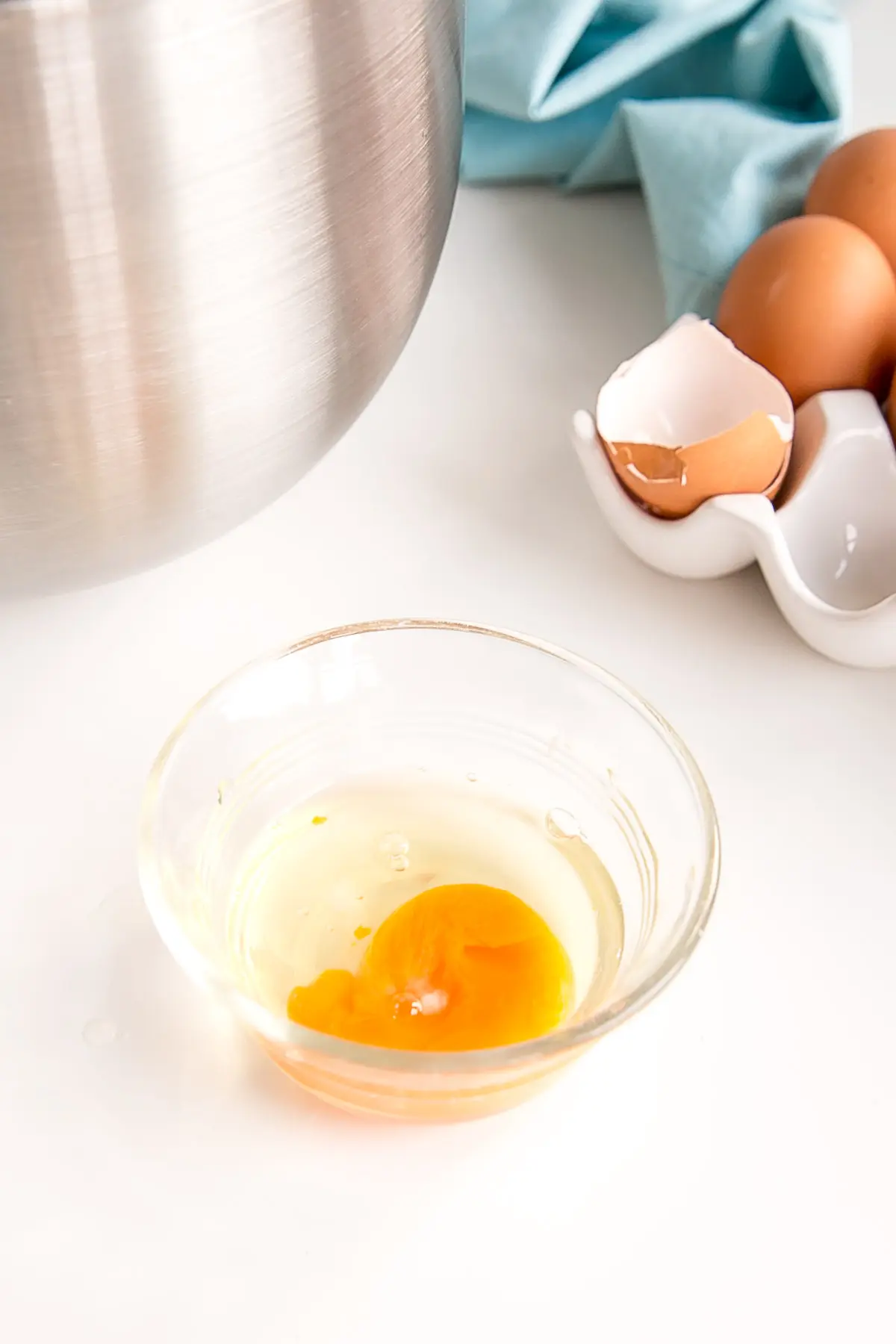
Note that the eggs do not need to be room temperature, since you’ll be cooking them anyhow.
Some people have had success with carton egg whites but, at this time, I cannot recommend them myself.
The carton whites I have tried have caused my meringue to stay flat and never stiffen. If you do want to experiment with carton whites, make sure the carton says something like “egg whites only” or similar.
Step #4 – Cook your egg whites & sugar
Once you’ve separated all your eggs, add them and your sugar into your mixer bowl and place it over the pot of simmering water.
I stir constantly at this point, with a clean hand whisk, to make sure the egg whites cook evenly. This process will take 2-3 mins depending on the number of egg whites you’re working with.
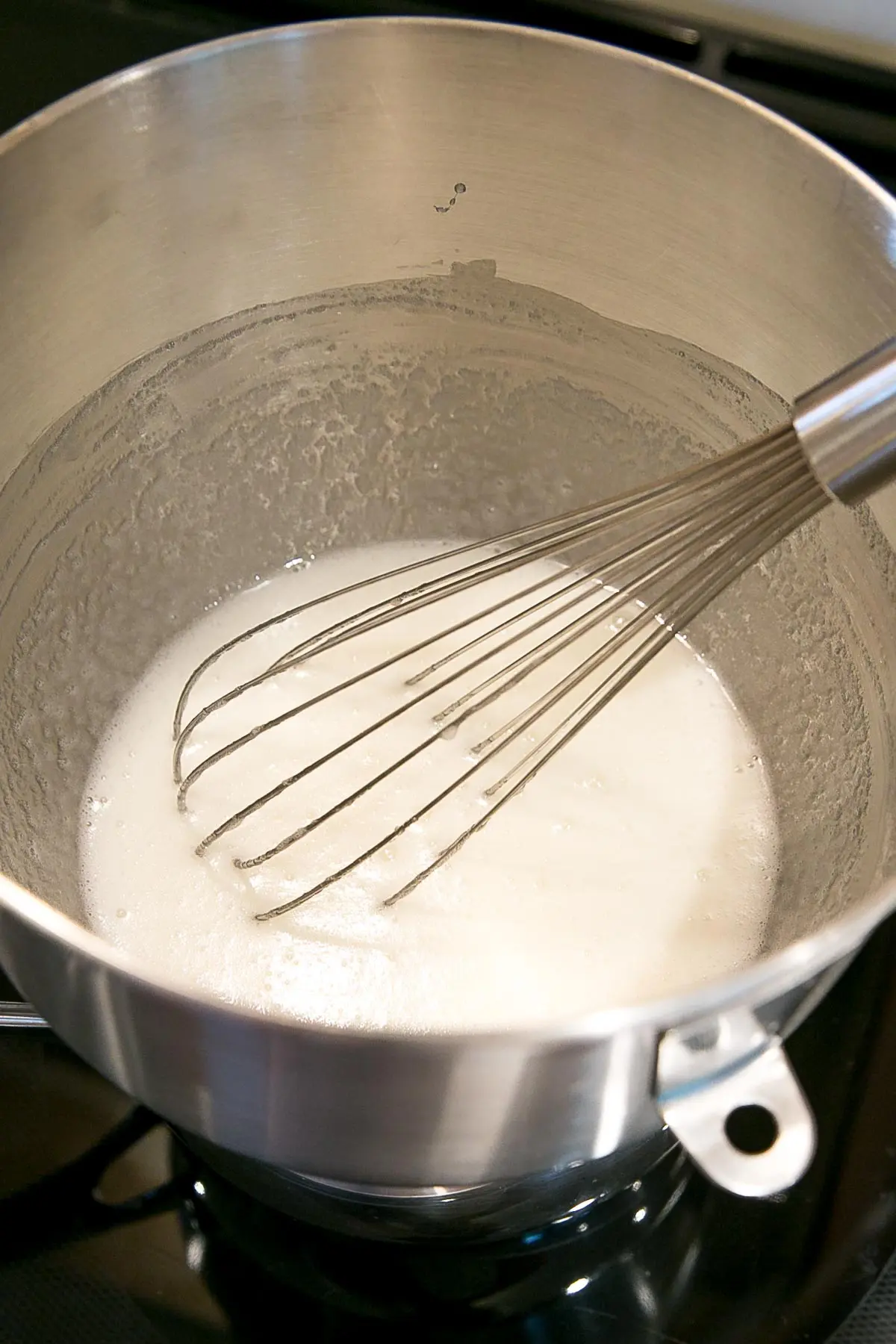
You’ll know the egg whites are done when the mixture is hot and no longer grainy to the touch.
I dip a (clean) finger into the mixture and rub it between my thumb and forefinger. If there is any graininess at all, I keep cooking them.

You want to make sure the mixture is hot to the touch too. Ideally, you’d use a candy thermometer to check that it has reached 160F. This is the most accurate way to make sure your whites are cooked fully.
I am too lazy to whip out a thermometer, and not concerned about eating raw eggs, so I do the touch test. If this is a concern for you, I recommend using a thermometer.
Step #5 – Whip your meringue
Remove your mixer bowl from the pot, wipe the bottom of the bowl, and place it on your stand mixer. Attach the whisk attachment and begin whipping.
I usually crank it right up to high speed (about 8-9 on my KitchenAid). You’ll want to whip this until the bowl is completely cool to the touch — this can take anywhere from 5-10mins.
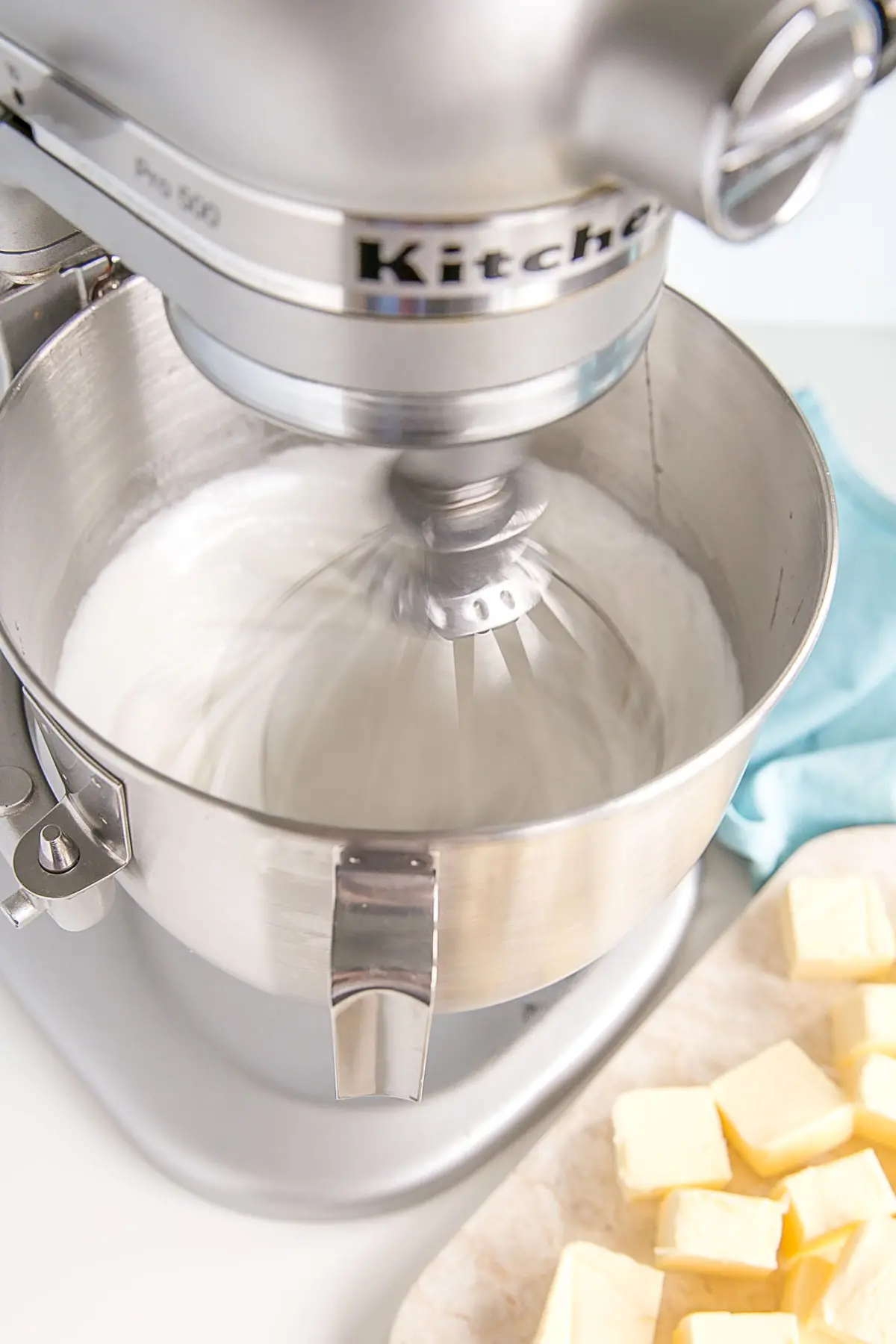
You’ll know if your meringue was successful if it holds a stiff peak. This is what it should look like – no droopy peaks!
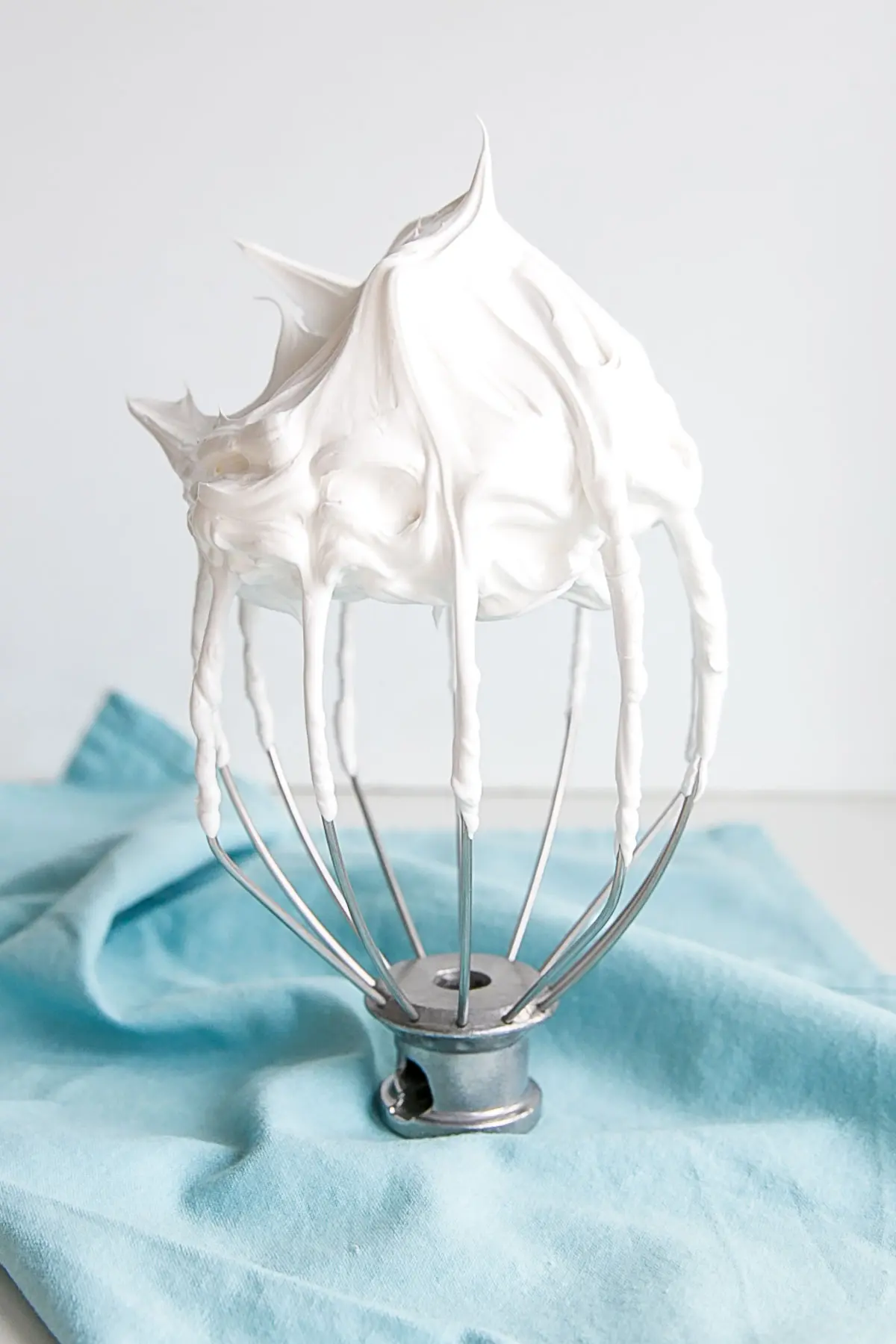
If your meringue is droopy, it was likely affected by either grease, yolk, or carton whites. See step #1. Unfortunately, if this happens, you will need to start over. There is no way to save the meringue at this point.
Step #6 – Cube your butter
While the meringue is whipping, cube your softened but still slightly cold butter. I roughly do 1″ or so cubes. It’s not an exact science, about 1 Tbsp or so each.
You will know your butter is the right consistency when you can press it with your finger and leave a bit of a dent in it.
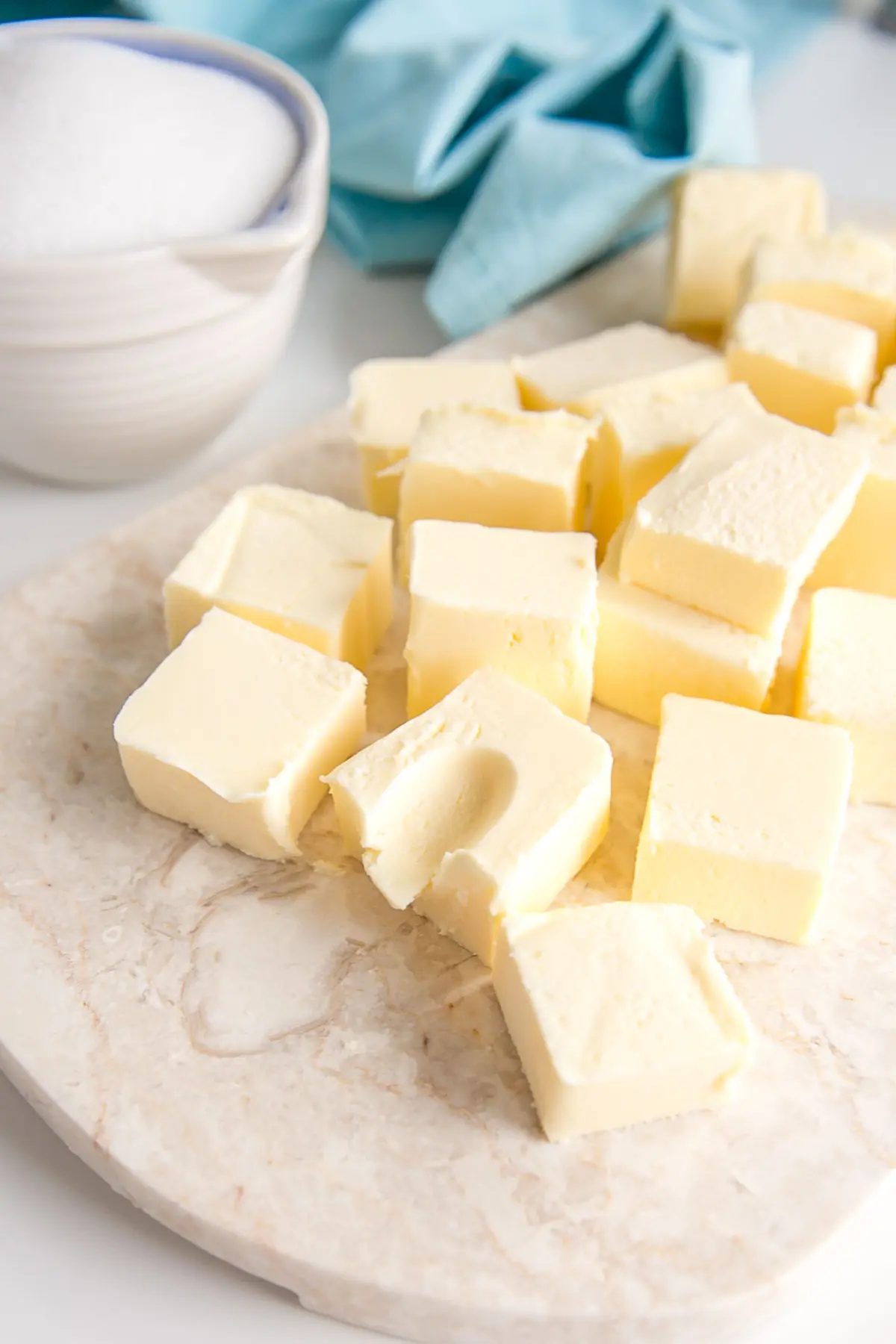
It’s important to note that your butter should not be too soft. If it’s so soft that you can press your finger through it easily, it will be too soft for your buttercream.
You can still use it, but you may need to chill your buttercream for a bit if it becomes soupy (see the Troubleshooting section below). I find it easier to deal with an SMBC that has used butter that’s too cold vs too soft.
Step #7 – Add the butter
When your meringue is completely cooled, stop your mixer and switch to the paddle attachment.
This isn’t critical, you can leave it on the whisk, but I like to switch to the paddle as I find that the whisk can incorporate too much air into the buttercream.
I also like that my paddle scrapes the sides of the bowl for me, which is a time saver.
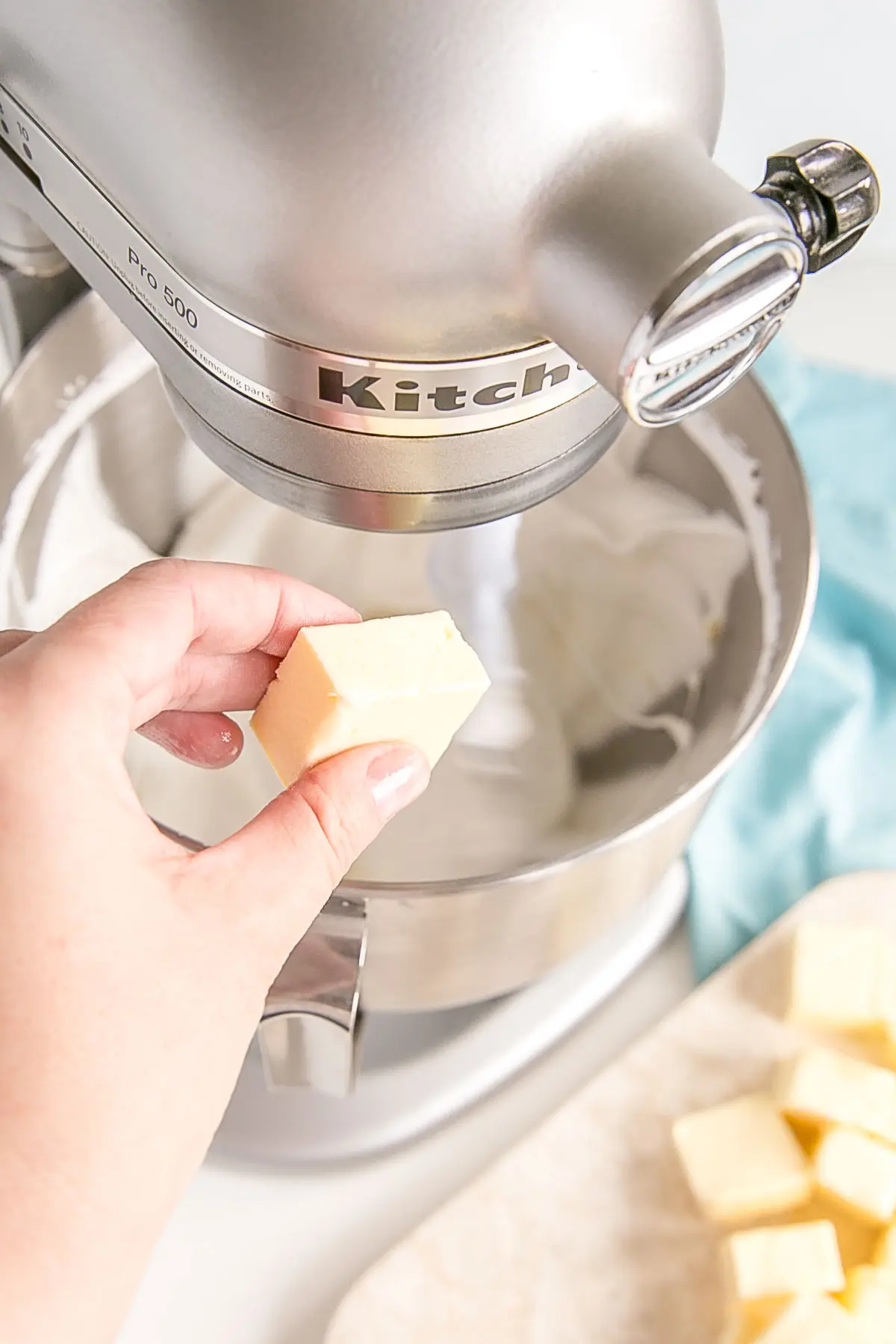
Set your mixer to medium speed (4 or so on a KitchenAid) and slowly start to add your butter cube by cube. Once all of the butter has been added, crank the mixer back up to high to beat the buttercream.
The buttercream can go through a few undesirable stages while it mixes. It can become soupy:
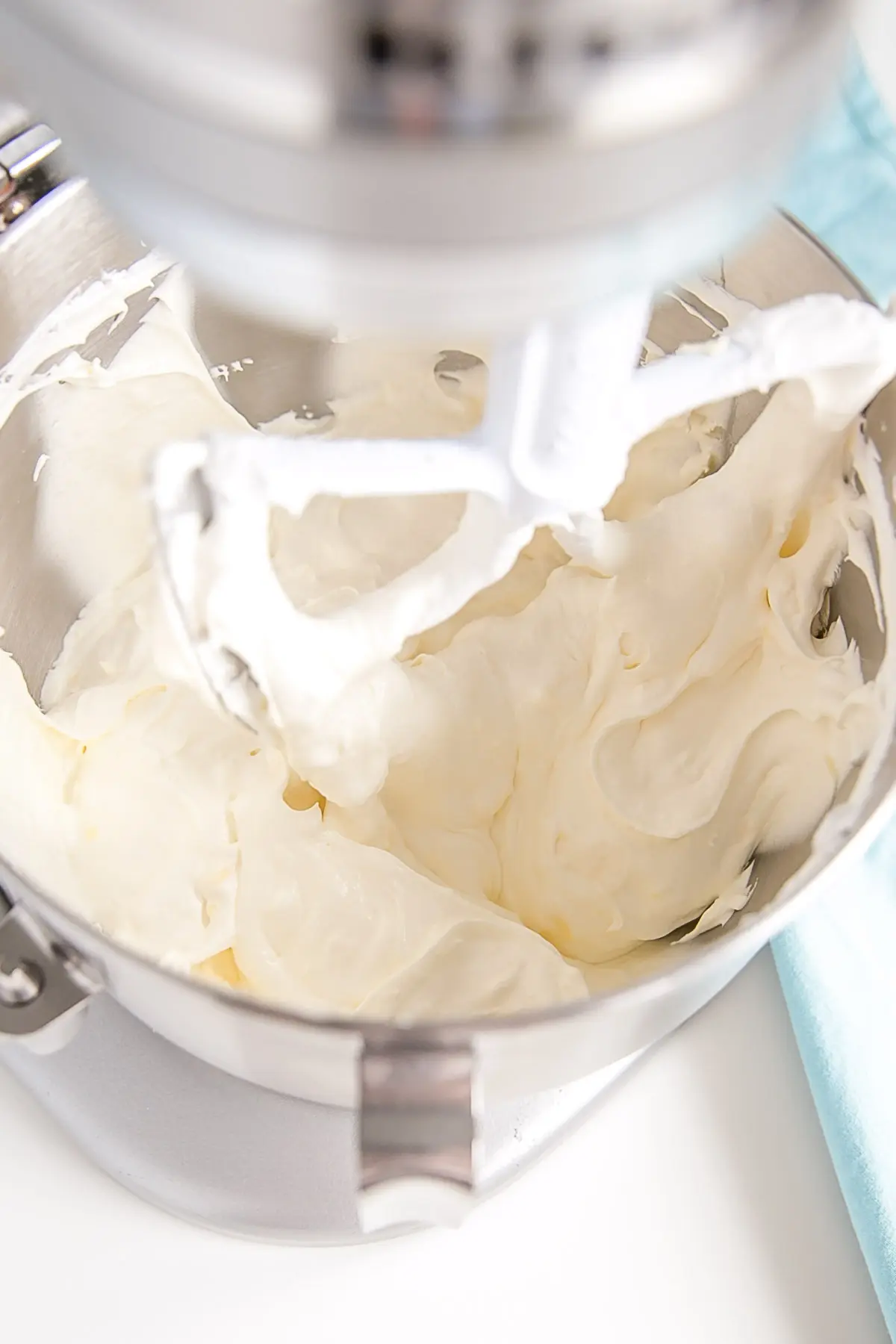
And it often curdles:

I find it best to walk away and come back after 5 mins to a (hopefully) perfect SMBC. See the Troubleshooting section below if this is not the case.
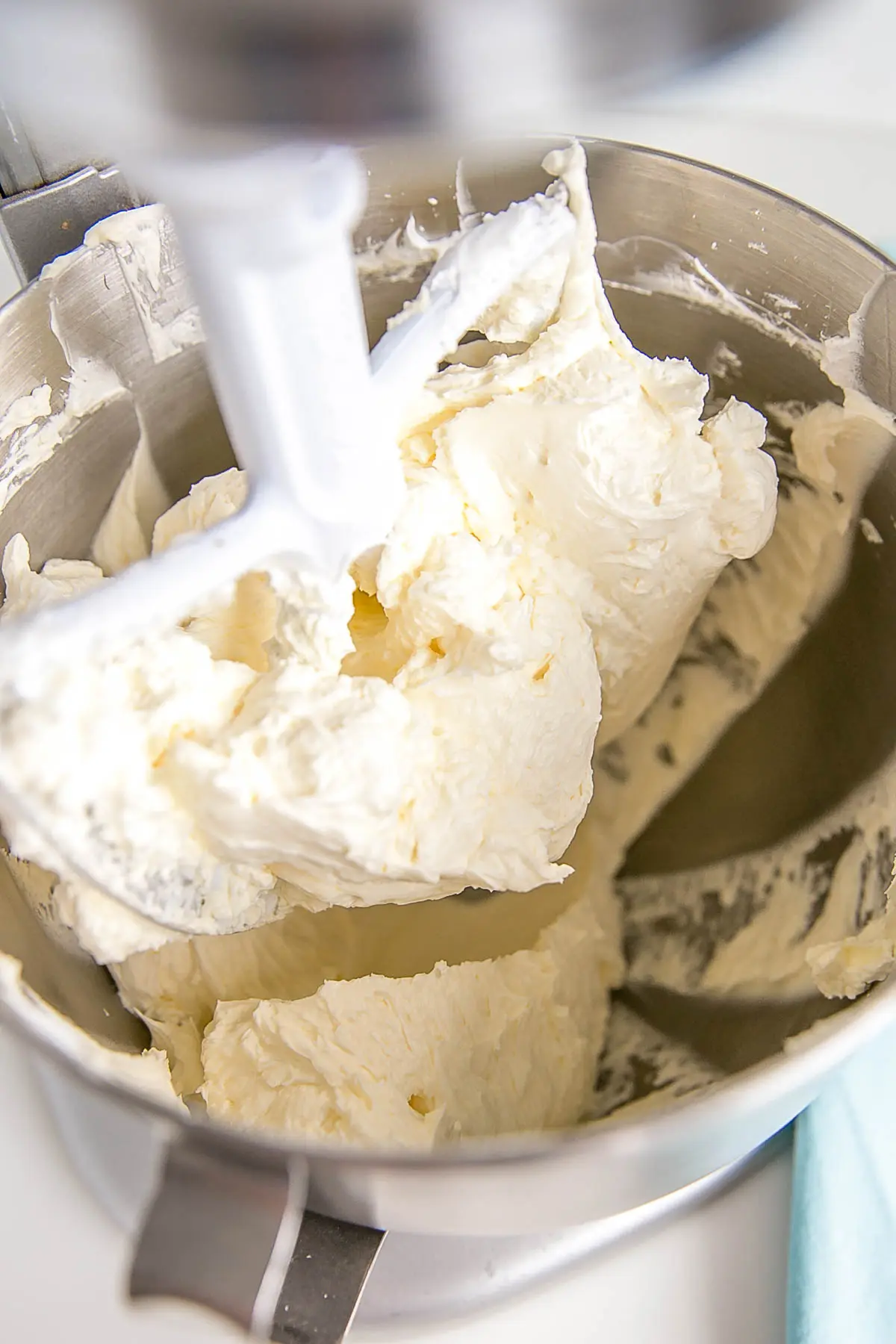
Once the buttercream is completely smooth, fluffy, and creamy, you can add in your flavorings (see below for a list of recipes).
How do I make my buttercream white?
This is a bit off topic, but also comes up often. SMBC can turn out a bit yellow depending on how much butter you use. This is not always a desirable effect, especially if you’re going for an all white cake.
The trick is to neutralize the yellow color by adding a bit of blue/violet to it.
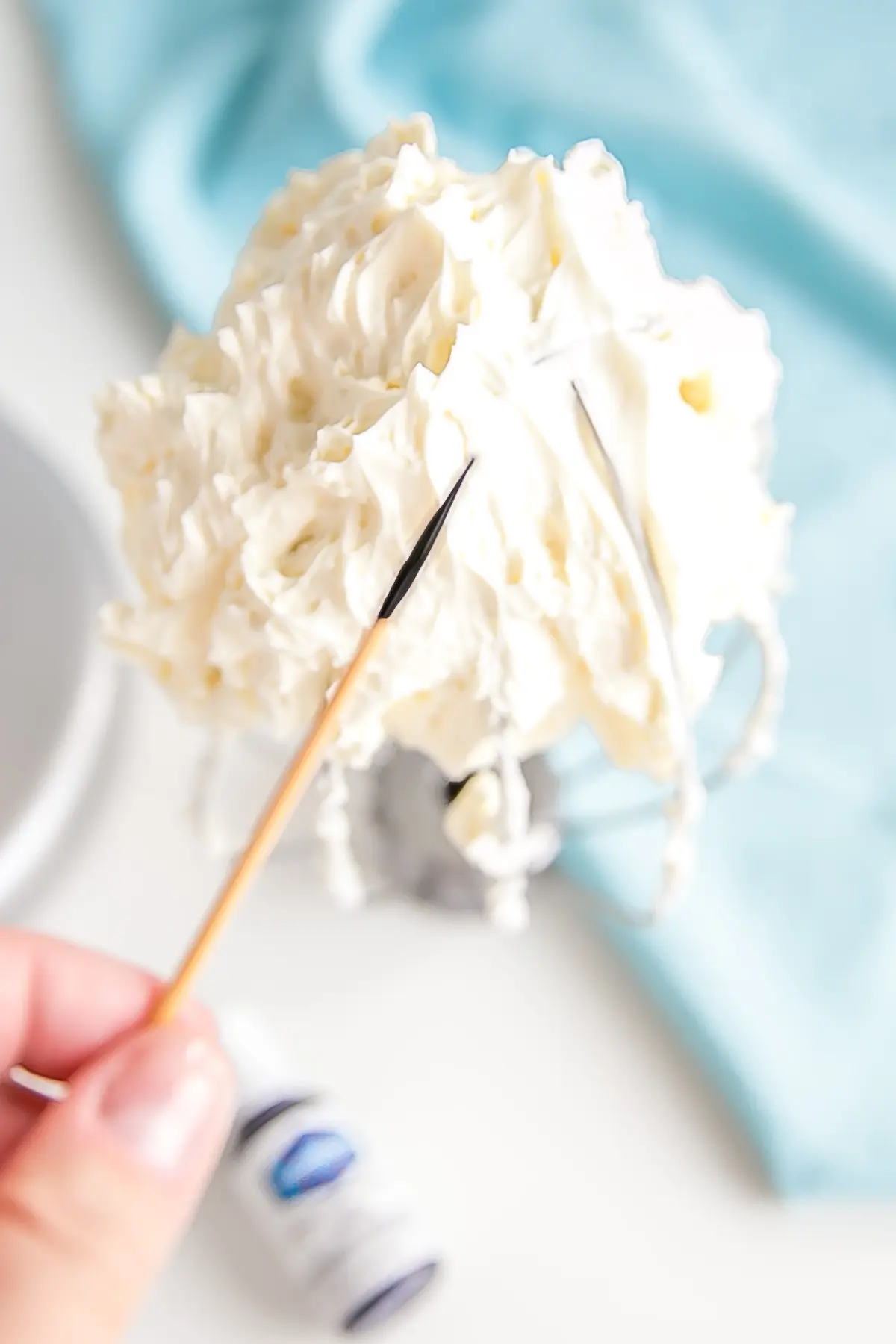
And I mean a bit. The amount on the toothpick above is more than I added. I basically swiped the toothpick over the buttercream on the whisk, so really only used one side of it.
I’d recommend starting with less and adding more as needed, or you’ll end up with a grey or bluish-looking buttercream.
Once the gel has been added (I used Americolor Violet), give the buttercream a good whip and you’ll see the yellow tint fade away. Add more color gel as needed.
Be sure to check out my detailed tutorial on How to Make Buttercream White for other tips.
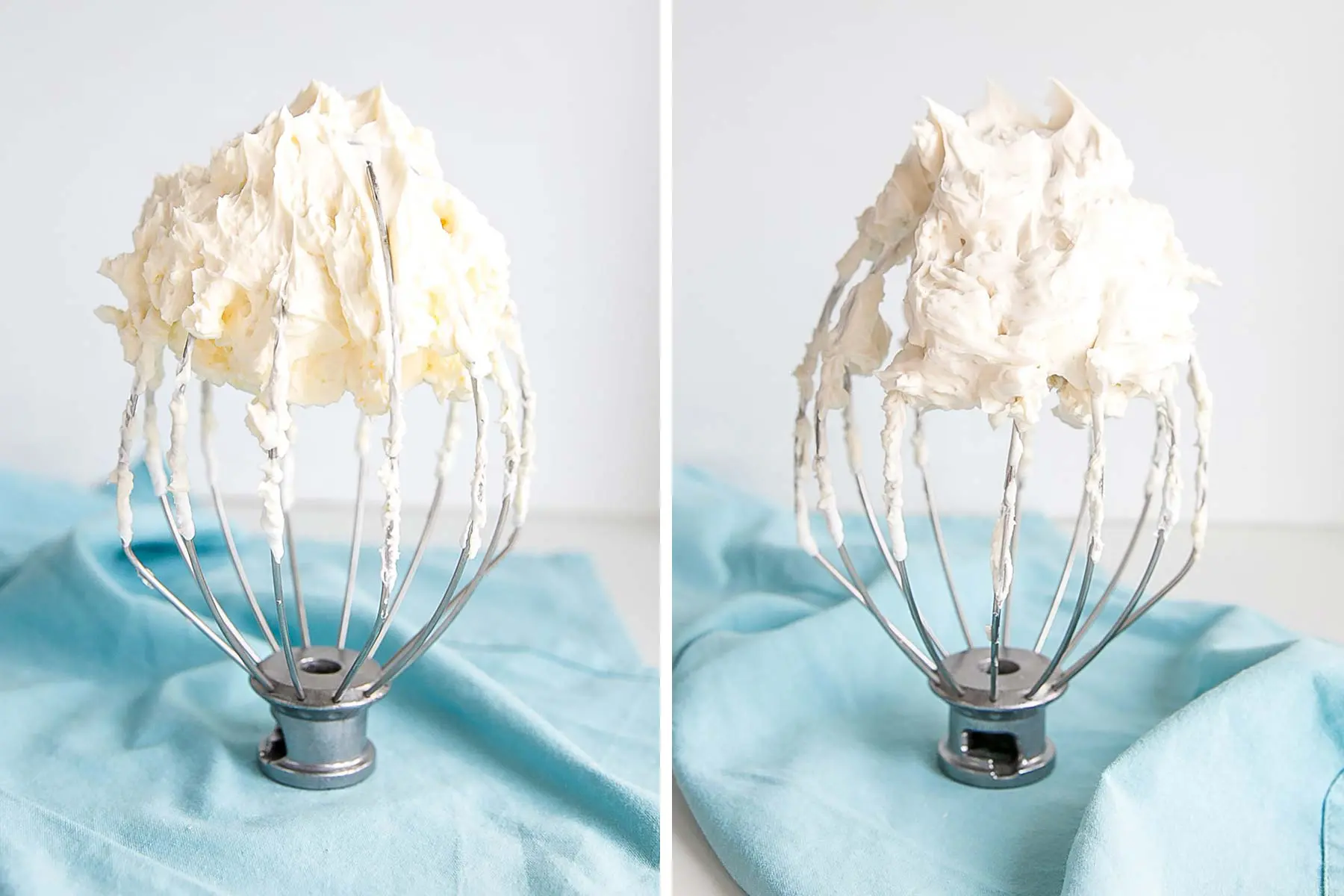
Troubleshooting Swiss Meringue Buttercream
Swiss meringue buttercream can be finicky. It’s temperamental and can cause a whole lot of unnecessary stress. The good news is that as long as your meringue was stiff before the butter was added, whatever issue you encounter after that is fixable.
Here are some common issues you may run into while making Swiss meringue buttercream, as well as my tips and suggestions on how to avoid/fix them:
- My meringue won’t whip up. This is either due to grease or egg yolks or both. See Step #1 of the tutorial above.
- My buttercream looks curdled. This is a common step when making SMBC. Once all the butter is added, it often goes through a phase where it looks curdled. If you keep whipping it, it will come together.
- My buttercream still looks curdled. If the temperature of the butter is too cold, it can be harder to get it to come together. You can either put it over a double boiler again like in Step #2, or warm the sides of the bowl with a hair dryer. One time, I had thawed some frozen SMBC and I didn’t completely bring it to room temperature before rewhipping. It looked like cottage cheese soup in my mixer. I thought it was a lost cause, but I heated the bowl a bit with a hair dryer and walked away for a few mins. When I came back it had come together perfectly! If you use the double boiler method, warm the buttercream just until the very edges start to melt, and then rewhip. You can also try to microwave 1/4 cup of the buttercream for a few seconds then drizzle it back into the buttercream with the mixer on low speed until it comes together.
- My buttercream is soupy. This is the opposite problem of curdled buttercream. This occurs because either the meringue was too warm when you added the butter or your butter was too soft, or both. Pop the whole bowl and whisk into the fridge for 20mins and then rewhip. Depending on how warm it was, you may need a couple of sessions in the fridge.
- My buttercream is grainy. This is due to the sugar not being dissolved properly in Step #4 above. Once the meringue is whipped, there is nothing you can do to fix this. It’s best to start over.
- My buttercream is greasy. SMBC is more buttery than an American buttercream, but it should not feel greasy. If you haven’t added more butter than the recipe calls for and your meringue was stiff, then the greasiness is likely due to the buttercream not being whipped for long enough. It’s also good practice to rewhip the SMBC if it’s been sitting out on the counter for a while.
- The buttercream gets hard in the fridge. This is normal. Just like the butter it’s made from, it will firm up to the consistency of butter in the fridge. When you let it come to room temperature it will soften again.
- It tastes too buttery. Some people just don’t like meringue buttercreams — they’re not for everyone! But the buttercream should be light and fluffy, not thick and greasy. If yours tastes like you’re eating a stick of butter, perhaps your meringue wasn’t whipped to stiff peaks before adding butter, or the butter was too cold, in which case it just needs some more whipping. Or you added too much butter.
Frequently Asked Questions
- Can I make Swiss meringue buttercream in advance? Yes! You can leave it at room temperature for a day or two, refrigerate for up to two weeks, or freeze it for up to 3 months. Be sure to store it in an airtight container. You must bring the buttercream completely to room temperature and rewhip before use. If the buttercream separates, it was still a bit too cold. See Step #3 above in the Troubleshooting section.
- How do I thaw my buttercream? Thaw it on the counter. It will be too hard if you thaw it in the fridge. I thaw mine overnight. Rewhip before use. See above.
- How long does Swiss meringue buttercream last? It will last for a day or two at room temperature, 2 weeks in the fridge, and 3 months in the freezer. Be sure it is properly stored in an airtight container or a freezer bag.
- Is Swiss meringue buttercream safe to eat? Yes. If you cook the eggs to 160F the buttercream will be safe to eat.
- Can I flavor Swiss meringue buttercream? Yes. Once the buttercream has come together, you can add any kinds of flavorings, extracts, powders, or chocolate — see list below for a list of recipes.
- Can I color Swiss meringue buttercream? Yes. Though SMBC is more difficult to color than an American buttercream. The color doesn’t take as well, so you may need more color gel. Be careful not to add too much, as the buttercream may split. You may want to look into powdered food coloring if you’re wanting to do very vibrant colors. I don’t recommend using liquid food coloring as it is not intense enough an can cause the buttercream to split. For more tips on getting rich, dark colors with SMBC see my Chocolate Peppermint Cake post.
- I don’t have a stand mixer. Can I use my hand mixer to make Swiss meringue buttercream? You probably can, but I do not recommend it. You’d be whipping forever! First to cool the meringue, and then when the butter is added. It can be a 10-15min process with a stand mixer, so I imagine it could take twice as long. So… doable if that’s all that you have at your disposal, but just know you’re in for a long haul.
Swiss Meringue Buttercream Recipe
The recipe I’m including below is the standard SMBC recipe that I use, though I tend to experiment a lot with it and sometimes add an extra egg white or use a bit less butter, depending on the amount of frosting I need.
I haven’t run into any issues doing this, but it’s important not to add more butter than the recipe calls for unless you’re also increasing the egg whites & sugar.
Swiss Meringue Buttercream Variations
- Blueberry (or any kind of berry)
- Brown Butter
- Brown Sugar
- Caramel
- Chocolate
- Cinnamon
- Coconut
- Dulce de Leche
- Espresso
- Honey
- Maple
- Mint
- Mocha
- Peanut Butter
- Vanilla
- White Chocolate
I hope you’ve found this guide helpful and that it’s given you the courage to give Swiss Meringue Buttercream a try! It truly is one of the most delicious buttercreams out there.

Swiss Meringue Buttercream Recipe
Ingredients
- 6 large egg whites
- 2 cups granulated sugar
- 2 cups unsalted butter softened but still a bit firm, cubed
- vanilla or other flavoring to taste see post for options
Instructions
Swiss Meringue Buttercream
- Place egg whites and sugar into the bowl of a stand mixer, whisk until combined.
- Place bowl over a pot with 1-2" of simmering water and stir constantly with a whisk until the mixture is hot and no longer grainy to the touch or reads 160F on a candy thermometer (approx. 3mins)
- Place bowl on your stand mixer and whisk on med-high until the meringue is stiff and cooled (the bowl is no longer warm to the touch (approx. 5-10mins)).
- Switch to paddle attachment (optional). Slowly add cubed butter and mix until smooth.
- Add flavorings as desired whip until smooth.
Notes
- This recipe makes enough to frost a two layer 8″ cake or a three layer 6″ cake.
- The recipe can be made with 3 cups of butter instead, if you need more frosting.
- See blog post for tips and troubleshooting.
Updated Nov 2, 2022. Originally published Jan 2, 2019

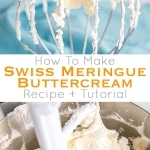


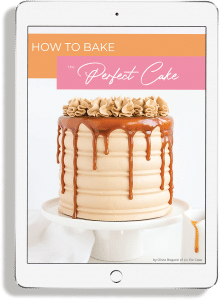










tanya says
What is the actual step between whipping your egg whites from the boiler and waiting for it to cool. I’ve achieved it doing it my way. However, what I noticed is that it takes more than 10 min for the egg whites to whip up on the kitchen aid about 10 -15 min. during that time, its cooling however by the time it whips up in 10-15 minutes, my egg whites are at stiff peaks however its still warm. Would you recommend me to continue whipping until its cool, leave it on the counter until cool, or put in fridge to cool before adding the butter?
Olivia says
Hi Tanya! Depending on the type of mixer and bowl the time can vary. Glass bowls I find take longer to heat and then cool down. Keep whipping until they are cool. You can place a bag of frozen peas or similar against the bottom of the bowl to help cool the merinuge.
Stephanie says
Hi! Today was my third attempt to make Swiss meringue buttercream (first time with your tutorial)…but it failed again 🙁 I can’t figure out what is going wrong. I wiped everything down with lemon juice, put my sugar and egg whites in a bowl above the simmering water, and whisked, but it never became smooth. I literally cooked/whisked for 20 minutes! Your post said it should take 2-3 minutes – any idea what I might be doing wrong??
Olivia says
Hi Stephanie! It might take a bit longer depending on the size of your pot/bowl and how much your water is simmering. Are you using a glass bowl by chance? Metal bowls help conduct the heat better. I would recommend a large enough pot so that the metal bowl is sitting fairly low down in it but not so much that the water is touching the bottom. Have it on a gentle simmer. You can also try with caster sugar instead which is more fine.
Gay Ann says
This is my number one go to frosting. So easy and delicious. Client’s number on choice
Thank you
Gay Ann
Olivia says
Hi Gay Ann! I’m so happy you love it. Thanks for the feedback 🙂
Anna says
It was amazing I used it on a cake and it was delicious
Olivia says
Hi Anna! So glad you loved it 🙂
Pam says
I’m excited to try this recipe! I was wondering if I could flavor this base SMBC with mascarpone, and if so how much would you recommend?
Olivia says
Hi Pam! Adding mascarpone may affect the texture of the buttercream. I’m going to experiment with it soon but I would use the full amount of butter and then add 1 cup or so of room temperature mascarpone one spoonful at a time.
Victoria says
This was so helpful for a first time baker! I am planning to pipe this onto 35 cupcakes in two weeks; the practice run went great! How much should I multiply the recipe for for 35 cupcakes?
Olivia says
Hi Victoria! So happy you found it helpful 🙂 The recipe as-is will frost 18-24 cupcakes depending on size. I would 1.5x the recipe or change the Servings to 9.
Carolynn says
I was wondering if I could frost cupcakes with the Swiss meringue buttercream the night before an event.
Olivia says
Hi Carolynn! For sure. If just the night before you can leave them out (covered) but the buttercream will be very soft. I recommend refrigerating as this will make transport easier too (if you’re transporting). If chilled, allow 2-3 hours to come to room temperature so the buttercream softens — it will get quite firm in the fridge.
Hilly says
Can I use fresh lemon juice to make lemon Swiss meringue? If so, what would the measurement be?
Olivia says
Hi Hilly! I would recommend adding either lemon curd (https://livforcake.com/lemon-curd/) or lemon zest. I worry that lemon juice could cause the buttercream to split if too much is added.
Lynette Oti says
Can I use salted butter instead if unsalted as it’s super difficult to find the latter where I live.
Thanks in advance..
Olivia says
Hi Lynette! I don’t recommend salted butter for buttercream because I find that it will overpower and you’ll really be able to taste the salt. It depends on how salty the butter is. You could always try it and see if you like it.
Cheska says
This recipe is great for my 2nd time trying a SMBC! I made sure that I wiped my bowls and whisks with vinegar, checked with the touch test, whipped the egg white mixture until it cooled off, and tossed in my cubed butter (not too soft but not too cold). The only problem I encountered is the taste since I adjusted the servings into 2 cups only, which asked for 2/3 cups of sugar and I realized that it will be bland a little too late. Over all I enjoyed the tips Olivia gave, its not too buttery but a bit tasteless (which is my fault hahaha). Will definitely try again with this recipe but will adjust the amount of sugar or not if I ever feel like baking a huge cake!
Olivia says
Hi Cheska! The plain vanilla version of SMBC is a bit on the boring side. You can punch it up a bit by adding some vanilla bean paste instead or more vanilla in general.
Melisa says
Hi I’ve made this recipe,3 times and every time I do it just becomes droopy. I always follow the recipe. It’s the part when I add in the butter, how long should I leave the butter out for it to be Cool to the touch.
Thanks
Olivia says
Hi Melisa! Sorry to hear you’re having trouble with this one. It’s not the butter that should be cool to the touch, it’s the mixer bowl that you have the meringue in. This can take about 10mins sometimes longer depending on your mixer. Is your meringue completely cool before you add the butter? Have you tried placing the whole bowl in the fridge for 20mins and rewhipping per my tips and troubleshooting above?
Amrita says
Hi Olivia! What would the approx weight be for 6 egg whites? 180 grams?
Olivia says
Hi Amrita! Yes, each large egg white is about 30g 🙂
Amrita says
Thank you so much for your prompt reply 💗 This is my first time making SMBC , hope it turns out well🤞🏼
Mercy Hodey says
Thanks for all the tips.
Can I combine shortening with the unsalted butter. For example half shortening and half butter?
Olivia says
Hi Mercy! I have only used butter myself so can’t say for sure how it will affect the texture. For best results use only butter.
Kate says
You cake photos are so stunning to look at! I previously made your lemon elderflower cake and it was delish. I did have some issues with the SMBC though (first time making it!) and as I’m planning to make the Pecan Pie cake for a birthday this weekend, I thought I’d ask some questions.
1.) I’m in the UK and wondered if you know the weight or volume of the large eggs/egg whites you use? I believe that our sizing of eggs is slightly different… In the UK, I think large eggs are about 63-73g. Maybe the variation doesn’t even matter?
2.) My main issue last time was struggling to even get the egg whites to stiff peaks, there was always a bit of a bend when I held the whisk up. Maybe this is why the icing ended up tasting quite buttery? I was quite diligent with wiping all the things in vinegar to remove grease but I’ll be more cautious this time. My question is that when you dip a finger in after heating to check if there is any graininess, could that not introduce oil? Even with clean hands I guess human skin can be quite oily. I may be overthinking this now…
Olivia says
Hi Kate! Thank you! For Swiss meringue buttercream, be sure to check my detailed tutorial here: https://livforcake.com/swiss-meringue-buttercream-recipe/ Re: the size of eggs, in school we learned that a large egg (without the shell) is about 50g (30g white, 20g yolk). A bit more/less won’t affect the meringue too much though. For the meringue, it will eventually bend. I have photos in that tutorial of what it should look like, but take a look at this photo here too: https://livforcake.com/homemade-marshmallow-fluff/. That is a stiff meringue but because the tail is longer it will eventually bend. A soft meringue is droopy/runny and doesn’t leave tracks. If your meringue is soft when you add the butter it will taste more buttery. However the buttery taste could be due to the buttercream not being whipped up enough once the butter is added. My tutorial talks about all the troubleshooting tips 🙂 Oh and I always wipe my finger with lemon juice too before testing the mixture.
Tammie says
I just made a batch of SMBC yesterday (not your recipe though). I always use the finger rub test to know when my mixture is ready. Until reading Kate’s concerns and your tip it never dawned on me that the oils on my clean finger could possibly mess with my meringue coming to stiff peaks, lol. I thank the both of you for bringing this to my attention. After reading your ingredient list as well as what size of cakes this amount will cover I have a question. When you say it will frost those sizes does that also include putting a dam around the layer/s and filling them too? The batch I made yesterday called for 4 lg egg whites, just a bit over 3 and a half sticks of butter (400grams) and 300 grams of castor sugar (not sure what that amounts to in cups). That batch of SMBC gave me enough to frost a 2 layer 8in square, put a dam on the 1st layer, cover the filling on that layer, do some minimal decor and I still had some frosting left over. I’m just wondering why I was able to do that using those measurements on that size of a cake vs what I’ll be able to do using your measurements?
Olivia says
Hi Tammie! The amount of frosting my recipe makes is enough to fill the cake with frosting, frost the outside, and have some left for decroating.
Kristen Harrell says
I have made a couple of your cakes and they are amazing! I have a question about the Swiss meringue recipes. On this page, it calls for 2 cups butter. For the coconut-lime cake, it calls for 3 cups butter. And for the vanilla latte cake, it calls for 1.5 cups butter. Why does the amount of butter keep changing? What’s the amount you recommend? I was thinking of making a single base amount and flavoring half with coconut milk powder and half with espresso powder. Would appreciate your advice! Thank you!
Olivia says
Hi Kristen! I change up the amount of butter depending on how much frosting I need. I would not use more than 3 cups or less than 1.5 cups for this amount of egg whites though. What size cake are you making? If it’s a two-layer 8″ or a three-layer 6″ then use the recipe here as is 🙂
Danica says
Absolutely love this recipe and have made it countless times! The last time I made the buttercream it was a bit too sweet, I added salt and the flavor was delicious but the texture was a bit grainy. How can I make it less sweet but still smooth. Should I replace some of the sugar with a pinch of salt while I’m whisking the egg whites and sugar over the stove?
Olivia says
Hi Danica! So happy you love this one 🙂 I wouldn’t replace some of the sugar but you can try adding a pinch of salt during that stage and see if it helps 🙂
Mirabelle says
I don’t have a mixer, I was wondering if I can use a blender to whip the egg whites
Olivia says
Hi Mirabelle! No, I don’t recommend using a blender.
Gee says
Please can I ask how I can go about doing this
If I make a fully decorated smbc cake on Thursday travel 4 hours (get to another city) refrigerate it till Saturday morning for the event. Would that be ok I’m planning on doing stencil work would that get ruined in the fridge? I know it might be safer to do American buttercream but I prefer the taste of your recipes smbc
TIA
Olivia says
Hi Gee! I think that will be fine. I generally don’t recommend refrigerating more than 2-3 days as the cake will start to dry out, so be sure to use simple syrup on the cake layers just in case (https://livforcake.com/simple-syrup-recipe/). I would also recommend freezing the cake before transport and transporting in a cooler if possible. 4 hours is a long time and you want to make sure it stays stable. I hope that helps!
Valeria says
Love this recipe!
I was wondering if I bought egg whites how many cups or grams should I use to be the equivalent of six egg whites?
Olivia says
Hi Valeria! I talk about that a bit in the post. I have not had success with carton whites myself as the meringue won’t whip to a stiff peak. If you want to use them though there is usually information on the carton about how much to use per white.
Danica says
Can I use salted butter to make the buttercream? The last time I made it it was very delicious but a bit too sweet.
Olivia says
Hi Danica! Personally, I find it way too salty using salted butter but it’s a matter of taste (and all salted butter is different too). You can do it though but it might be too salty. You could also just add a pinch of salt or so to the buttercream to help cut the sweetness. Then you can control it better.
Michelle says
Hi is this supposed to be a softer buttercream? I felt like it could have been thicker but didn’t want to over whip and seperate it.
Olivia says
Hi Michelle! No, it’s not supposed to be on the softer side. It should be sturdy and easy to pipe with. It’s possible that it was a bit warm and needed some time in the fridge.
Helen says
Hi I wanted to frost 12 cupcakes should I cut the recipe in half?
Olivia says
Hi Helen! Yes, I would do half.